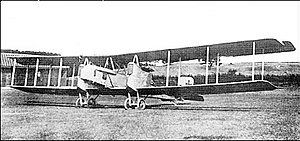| Gotha G.III | |
|---|---|
 | |
| General information | |
| Type | Bomber |
| Manufacturer | Gothaer Waggonfabrik |
| Designer | Hans Burkhard |
| Status | retired |
| Primary user | Luftstreitkräfte |
| Number built | 25 |
| History | |
| Manufactured | 1916 |
| Introduction date | 1916 |
| First flight | 1916 |
The Gotha G.III was a twin-engine pusher biplane heavy bomber used by the Luftstreitkräfte (Imperial German Air Service) during World War I. It succeeded the G.II in production and differed primarily in powerplant and in armament details. The G.II's unreliable Mercedes D.IV was replaced by the new inline six-cylinder 190 kW (250 hp) Mercedes D.IVa engine. The G.III also had an extra 7.92 mm (0.312 in) machine gun firing through a ventral gun opening to protect the underside of the tail.
Operational history
Most of the 25 G.III aircraft produced were delivered to Kampfgeschwader der Obersten Heeresleitung (Kagohl) 1, operating in the Balkans out of Hudova which were under direct control of the Oberste Heeresleitung high command of the German Army. Combat service of the G.III was limited and its most notable accomplishment was in September 1916, when a formation of G.IIIs destroyed a railway bridge over the Danube River at Cernavodă, Romania. It also saw use by Kagohl 2 on the Western Front, operating from Freiburg. Following the delivery of the G.IIIs to this unit, its commander complained to Berlin about the performance of the aircraft because they were outrunning their escort fighters. In September 1917, surviving aircraft were relegated to training units.
Operators
Specifications
General characteristics
- Crew: Three
- Length: 12.2 m (40 ft 0 in)
- Wingspan: 23.7 m (77 ft 9 in)
- Height: 3.9 m (12 ft 10 in)
- Wing area: 89.5 m (963 sq ft)
- Empty weight: 2,383 kg (5,254 lb)
- Gross weight: 3,618 kg (7,976 lb)
- Powerplant: 2 × Mercedes D.IVa , 193 kW (260 hp) each
Performance
- Maximum speed: 135 km/h (84 mph, 73 kn)
- Endurance: 3 hours 45 minutes
Armament
- 2 to 3 × 7.92 mm (0.312 in) Parabellum MG14 machine guns
- 500 kg (1,100 lb) of bombs
See also
Related development
Aircraft of comparable role, configuration, and era
Related lists
References
Citations
- Murphy, 2005, p.175
References
- Grosz, Peter M. (1966). The Gotha GI - GV. Leatherhead, Surrey: Profile Publications.
- Grosz, Peter M. (1994). Gotha!. Berkhamstead, Hertfordshire: Albatros Productions.
- Herris, Jack (2013). Gotha Aircraft of WWI: A Centennial Perspective on Great War Airplanes. Great War Aviation Centennial Series. Vol. 6. Charleston, South Carolina: Aeronaut Books. ISBN 978-1-935881-14-8.
- Klaauw, Bart van der (March–April 1999). "Unexpected Windfalls: Accidentally or Deliberately, More than 100 Aircraft 'arrived' in Dutch Territory During the Great War". Air Enthusiast (80): 54–59. ISSN 0143-5450.
- Metzmacher, Andreas (2021). Gotha Aircraft 1913-1954: From the London Bomber to the Flying Wing Jet Fighter. Brimscombe, Stroud: Fonthill. ISBN 978-1-78155-706-8.
- Murphy, Justin (2005). Military Aircraft, Origins to 1918: An Illustrated History of Their Impact. ABC-CLIO. ISBN 1851094881.
| Gotha aircraft | |||||||
|---|---|---|---|---|---|---|---|
| Company designations pre-1918 | |||||||
| Idflieg designations 1914-1918 | |||||||
| RLM designations 1933-1945 | |||||||
| Project numbers | |||||||
| Idflieg G, GL, K, L and N-class bomber designations | |||||||||||||||||||||||||
|---|---|---|---|---|---|---|---|---|---|---|---|---|---|---|---|---|---|---|---|---|---|---|---|---|---|
| G- class |
| ||||||||||||||||||||||||
| GL- class |
| ||||||||||||||||||||||||
| K- class |
| ||||||||||||||||||||||||
| L- class |
| ||||||||||||||||||||||||
| N- class |
| ||||||||||||||||||||||||
| G = Grossflugzeuge (large airplane), GL = Grossflugzeuge Leicht (light large airplane) K = Kampfflugzeug (battleplane), renamed as G-class, L = bomber midway between K/G and R-classes N = Nacht (night) | |||||||||||||||||||||||||